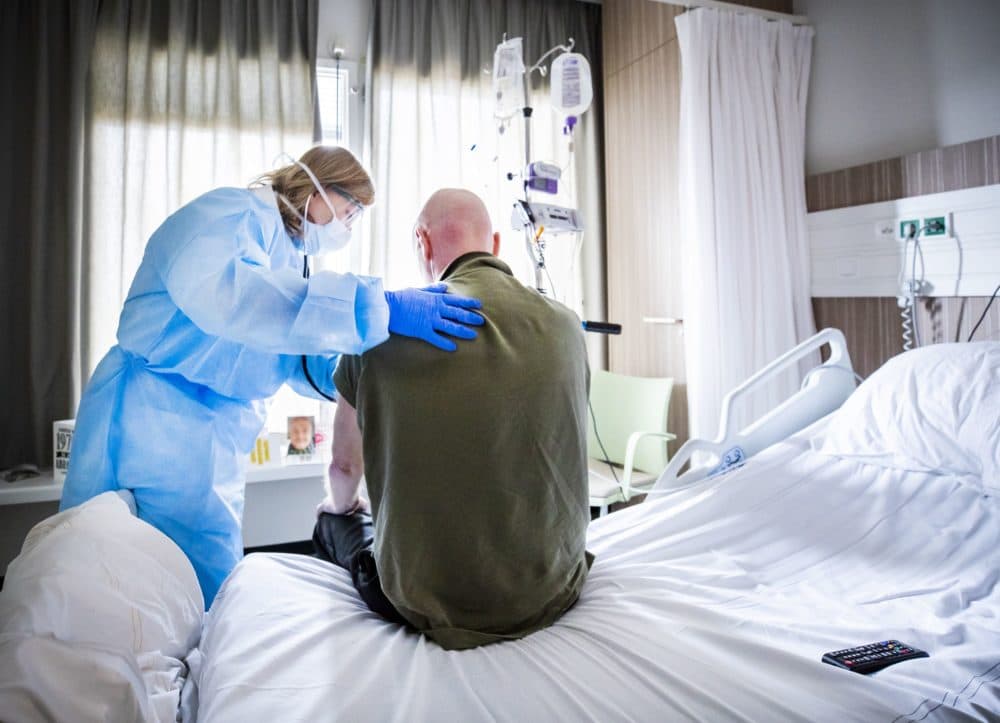Advertisement
'It's Not A Hoax': 2 Coronavirus Survivors Share Different Journeys With COVID-19
Resume
More than 1 million people in the U.S. have recovered from COVID-19, according to data from Johns Hopkins University.
But even those who have gotten through the disease’s initial effects can still have lingering symptoms. Two women who had very different experiences with the coronavirus are still dealing with it months later.
Christa Thibodeau, a Latina woman from New Braunfels, Texas, was hospitalized with COVID-19 after experiencing shortness of breath in April. Jennifer Dunlap, a Black woman from Columbus, Georgia, contracted the virus but only experienced mild symptoms.
Thibodeau says she first started to experience symptoms when she developed a massive headache and shortness of breath. She was admitted to the hospital with bilateral pneumonia, suffering through a fever of 104 degrees at its peak, coughing and digestive issues. She was eventually released from the hospital, but she says she is still dealing with that initial headache.
“I've never been prone to headaches, but this was one of the strongest headaches that I've ever had in my life,” Thibodeau says. “In fact, I still have the headache. It's been 112 days, and I'm still suffering from that same headache.”
After undergoing two MRIs and a spinal tap, Thibodeau says her doctors believe she has intracranial hypertension due to inflammation in her brain while she had the virus.
Even though it took her six weeks to finally test negative for the coronavirus, her doctors say she is no longer contagious. Thibodeau says it’s been “a little bit disheartening” going to follow up appointments because many are still afraid of the virus.
“This past visit to the neurologist, I literally had the nurse grab her items and leave as if I had the plague. It was upsetting,” she says. “Some people are compassionate. Some are not.”
Dunlap is also still dealing with the residual effects of COVID-19. She says she only experienced mild symptoms after being exposed to the coronavirus at work.
“I started feeling like these little pinches kind of throughout my body, which was almost like a nerve going off. Like it kind of felt like a little stabbing feeling,” she says. “The next morning I woke up and I had stomach issues … and then I had like a burning sensation in my back that increased into the night and kind of felt like IcyHot was all over my back.”
Dunlap never had a fever and says she “didn’t cough one time.” But she still decided to get tested because of the known exposure at work.
She did an at-home test and visited a drive-thru testing center, and both tests came back negative. The person who she had the known exposure with also tested negative. It wasn’t until that person’s symptoms increased that Dunlap took another test a week later, and it was positive.
Dunlap says she is grateful she only experienced mild symptoms, but she has been isolated from her husband and three sons while she awaits a negative test result.
“I've been by myself,” she says. “I just tested again [on Monday] to see if that was going to give me a negative test result because I absolutely would feel terrible if anyone else in my family or my circle were to experience this, even if they had a mild case. I wouldn't want that at all for my loved ones.”
Members of some racial and ethnic groups are more likely to contract the coronavirus or experience severe illness, according to the Centers for Disease Control and Prevention. Black people are five times more likely to be hospitalized with COVID-19 than white people. For the Latinx population, the rate is four times more than white people.
Both women say many people in their community are still failing to grasp the severity of the coronavirus.
“I feel like here locally with the African American population ... it seems to me people don't really believe what's happening,” Dunlap says. “Someone who they know has to go through something terrible with it in order for [people] to really understand.”
Thibodeau says she has dealt with similar levels of doubt in her community, especially when it comes to the debate over wearing masks and social distancing.
“I wish that people would respect one another,” she says. “I know for me and my family, it's left an indelible mark, especially on me and my health. And I wish people would take it seriously. It's not a hoax. It's not a joke.”
Chris Bentley produced and edited this interview for broadcast with Peter O'Dowd. Samantha Raphelson adapted it for the web.
This segment aired on July 14, 2020.

